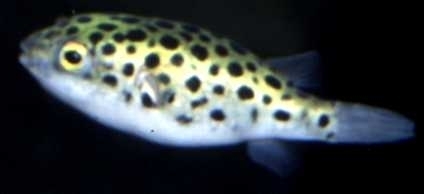
Photo courtesy of puffernet.tripod.com Physical description:
|
| General information:
Puffers are of the family Tetraodontidae, meaning
four toothed. They have a club-shaped and unarmored body. Green Puffer
is a freshwater to light brackish species inhabiting rivers, lakes and
flood plains. It is mostly carnivorous (mollusks, crustaceans, invertebrates)
and also will eat vegetation. Generally a peaceful fish, but as it gets
older it can get more aggressive, especially, when harassed by potential
predators and a notorious fin-nipper. Green puffer with a smooth belly
is very popular, it is often confused wity t. nigroviridis, and
also t. schoutedeni, which are more club-shaped. The green puffer
exhibits a torpedo shaped body, with a longer sloping head and back region.
|
| Personal Observations:
The young green puffers in the Fort Worth Zoo
aquarium can be discribed as cute and docile. The spotted puffer's body
conforms to the standard puffer shape with a white underbelly and yellow/green
top covered in black spots. This top coloring ranges from dark green
to fluorescent green to yellow. Their eyes are an almost metallic blue
and appear to reflect light.
|
| Source Materials and Related Links: |
|
Send E-mail to: moonsuk76@hotmail.com or to mac@whozoo.org |

WhoZoo Home
WhoZoo Animal Index
Fish at the Fort Worth Zoo